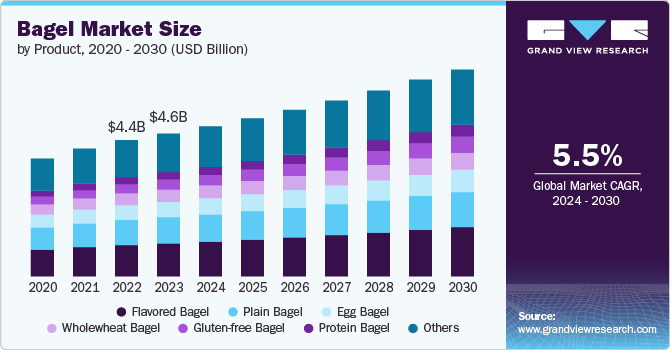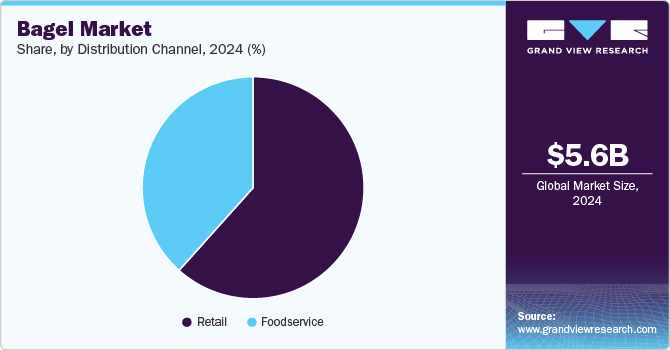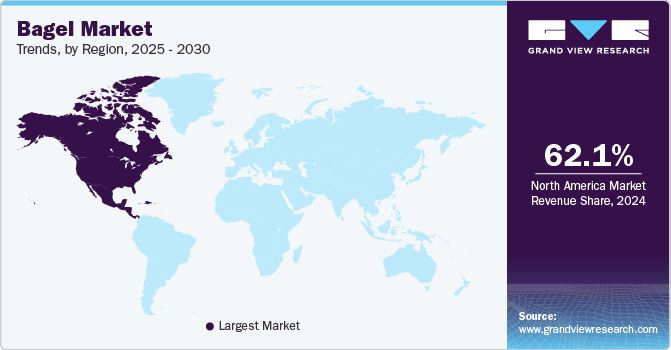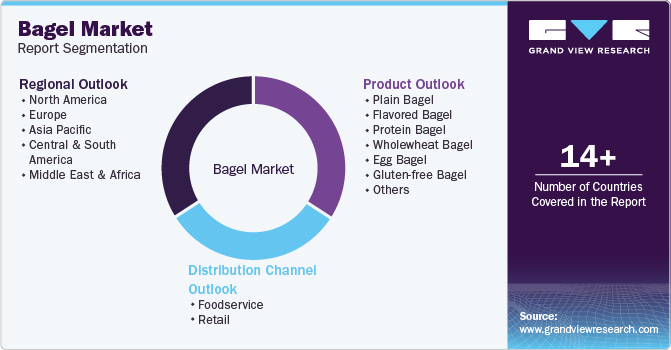- Home
- »
- Consumer F&B
- »
-
Bagel Market Size, Share & Trends, Industry Report, 2030GVR Report cover
![Bagel Market Size, Share & Trends Report]()
Bagel Market Size, Share & Trends Analysis Report By Product (Plain Bagel, Flavored Bagel, Protein Bagel, Wholewheat Bagel, Egg Bagel, Gluten-free Bagel), By Distribution Channel (Foodservice, Hypermarkets & Supermarkets), By Region, And Segment Forecasts, 2025 - 2030
- Report ID: GVR-4-68040-414-3
- Number of Report Pages: 80
- Format: PDF, Horizon Databook
- Historical Range: 2018 - 2024
- Forecast Period: 2025 - 2030
- Industry: Consumer Goods
Bagel Market Size & Trends
The global bagel market size was valued at USD 5.58 billion in 2024 and is expected to grow at a CAGR of 4.8% from 2025 to 2030. One of the most significant drivers of the market is the growing demand for convenient and quick breakfast options. Today, consumers are increasingly seeking out foods that are easy to prepare and consume on the go. Bagels can be easily toasted and paired with a variety of spreads or fillings and fit this need perfectly. Furthermore, the rise of bagel cafés and chains, particularly in North America and Europe, has significantly contributed to the growth of the market. Chains like Bruegger's Bagels, Einstein Bros. Bagels, and Panera Bread have capitalized on the demand for fresh, high-quality bagels served in a café environment.

Bagels have deep cultural roots, particularly within Jewish communities in Eastern Europe. The migration of Jewish populations to North America in the late 19th and early 20th centuries brought bagels into mainstream American culture. Over time, the bagel transitioned from a niche ethnic food to a widely consumed product. This cultural shift played a crucial role in the initial expansion of the market, especially in urban centers like New York City. Today, the cultural legacy of bagels continues to drive their popularity, particularly in regions with strong Jewish heritage, which is expected to augment the growth of the market during the forecast period.
The health and wellness trend has significantly impacted the market. As consumers become more health-conscious, there has been a growing demand for bagels that cater to specific dietary needs. This includes gluten-free, low-calorie, high-fiber, and protein-enriched bagels. Manufacturers have responded by introducing products that align with these preferences. For instance, Western Bagel Baking Corp. offers "Alternative Bagels" that are lower in calories and carbs, appealing to consumers on weight management programs. The rise of plant-based diets has also led to the introduction of vegan bagels, which exclude dairy or egg-based ingredients.
Furthermore, there is a growing consumer preference for authentic and artisanal products, which has benefited the market. Artisanal bagels, often made using traditional methods and high-quality ingredients, are perceived as being of superior quality compared to mass-produced alternatives. This trend has given rise to boutique bagel shops and bakeries that emphasize hand-rolled, kettle-boiled bagels made from organic or locally sourced ingredients. St-Viateur Bagel in Montreal, for instance, is renowned for its traditional method of bagel making, which has attracted a loyal customer base both locally and internationally. The demand for authenticity and craftsmanship has driven the growth of this segment of the market.
Manufacturers in the market have been proactive in responding to consumer demands for variety and innovation. Traditional plain or sesame bagels have given way to a wide array of flavors, from blueberry and cinnamon raisin to more adventurous options like everything bagels and jalapeño cheddar. This diversification of flavors has helped attract a broader consumer base, catering to different taste preferences. Additionally, the introduction of bagels made from alternative grains, such as whole wheat, gluten-free, and low-carb options, has expanded the market to include health-conscious consumers. Companies like Einstein Bros. Bagels have launched new flavors and limited-edition products to keep the market engaged.
Product Insights
The plain bagel segment accounted for a revenue share of 31.3% in 2024. The demand for plain bagels is being driven by several key factors in the food industry. One of the primary drivers is the increasing focus on health and wellness. With consumers becoming more health-conscious, there has been a noticeable shift toward healthier versions of traditionally carbohydrate-heavy foods like bagels. Many companies are now producing plain bagels made from whole grains, offering low-carb or gluten-free varieties to meet the demands of health-focused consumers. This trend is evident in brands such as Dave’s Killer Bread and Thomas', which offer whole grain or reduced-calorie plain bagels that appeal to a broader health-conscious audience.
The gluten-free bagel market is expected to grow at a CAGR of 6.4% from 2025 to 2030. The demand for gluten-free bagels is driven by several key factors, primarily influenced by dietary preferences, health awareness, and changing consumer behaviors. One of the major drivers is the rise in gluten intolerance and celiac disease awareness. As more people are diagnosed with celiac disease or gluten sensitivity, the demand for gluten-free products, including bagels, has surged. For example, brands like Udi’s and Canyon Bakehouse have developed gluten-free bagels that cater to individuals with these dietary restrictions, providing safe, high-quality alternatives to traditional wheat-based products.
Distribution Channel Insights
Sales through retail channels such as hypermarkets & supermarkets, convenience stores, and online, among others, accounted for a revenue share of 61.6% in 2024. Traditionally, bagels were primarily sold in bakeries and specialty stores, but the rise of supermarkets, hypermarkets, and convenience stores has made bagels more accessible to a broader audience. Additionally, the growth of e-commerce has provided consumers with the convenience of ordering bagels online and having them delivered to their doorstep. This has been particularly beneficial for brands that have a weak physical retail presence but can reach consumers through online sales channels.
Furthermore, retail stores offer the convenience of one-stop shopping, where consumers can purchase all their groceries, including bagels, in a single trip. This convenience factor is particularly appealing to busy consumers, driving higher foot traffic and sales through retail outlets for the bagel across the world during the forecast period.

Sales of bagels through food service are expected to grow with a CAGR of 4.3% from 2025 to 2030. The growth of café culture, particularly in urban areas, has contributed to the rising demand for bagels in food service outlets. Cafés and coffee shops often feature bagels on their menus, paired with coffee or other beverages, catering to consumers looking for a quick and satisfying meal or snack. Furthermore, food service outlets offer the advantage of customization, allowing consumers to personalize their bagels with various toppings, spreads, and fillings. The ability to tailor their meals to individual preferences enhances the appeal of bagels through the food service channel. Additionally, the perception of freshness and quality at food service establishments further drives consumer demand.
In addition, foodservice operators have responded to the growing demand for healthier options by offering whole grain, multigrain, and gluten-free bagels on their menus. The inclusion of these healthier alternatives has attracted health-conscious consumers to foodservice establishments, contributing to the rapid growth of bagel sales in this channel.
Regional Insights
North America bagel market accounted for a revenue share of 62.1% in 2024. Bagels have a deep cultural significance in North America, particularly in urban centers with large Jewish populations like New York City and Montreal. The traditional New York-style bagel, known for its dense texture and distinct flavor, has become a staple in American cuisine. North American consumers are increasingly seeking variety and innovation in their food choices. Manufacturers have responded by introducing new flavors, healthier options like whole wheat and multigrain bagels, and specialty products such as gluten-free and low-carb bagels. This innovation caters to a broad audience, from traditionalists who prefer classic plain or sesame bagels to health-conscious consumers looking for protein-enriched or low-calorie options, thus driving the demand for bagel market in this region during the forecast period.

U.S. Bagel Market Trends
The bagel market in the U.S. is expected to grow at a CAGR of 5.1% from 2025 to 2030. The U.S. foodservice sector, particularly the café culture, has been instrumental in driving the bagel market. Bagels are a staple item in many coffee shops and breakfast chains, often served with cream cheese, smoked salmon, or as part of breakfast sandwiches. The convenience and versatility of bagels make them a popular choice for on-the-go consumers, contributing to their sustained demand in the foodservice industry, which is expected to drive the growth of the market during the forecast period.
Asia Pacific Bagel Market Trends
The bagel market in Asia Pacific is expected to grow at a CAGR of 6.8% from 2025 to 2030. The influence of Western food culture in Asia Pacific, particularly in urban areas, has led to the growing popularity of bagels. As more consumers in the region are exposed to Western cuisine through travel, media, and the presence of international food chains, bagels have gained acceptance as a trendy and versatile food option. This is particularly evident in countries like Japan, South Korea, and Australia, where Western-style cafés and bakeries are popular. Thus, the above mentioned factor is expected to drive the demand and growth of bagel market in the region during the forecast period.
Europe Bagel Market Trends
The bagel market in Europe is expected to grow at a CAGR of 5.2% from 2025 to 2030. The demand for artisanal and premium food products is strong in Europe, and this trend extends to the bagel market. European consumers are willing to pay a premium for high-quality, freshly baked bagels made with natural ingredients. This has led to the growth of artisanal bagel bakeries across Europe, particularly in countries like the UK, France, and Germany, where consumers appreciate the craftsmanship and quality of artisanal products. Furthermore, the retail channel in Europe is also seeing growth in the bagel market, driven by the increasing availability of bagels in supermarkets and specialty stores, thus, which is expected to contribute to the growth of the bagel market in Europe during the forecast period.
Key Bagel Company Insights
The global market is characterized by numerous well-established and emerging players. Recognizing the increasing demand for healthier food products, manufacturers are developing bagels that cater to health-conscious consumers. This includes whole wheat, multigrain, and high-protein bagels, as well as options that are low in carbohydrates or calories. Furthermore, to appeal to a broader audience, manufacturers are expanding their product lines with a variety of flavors. Everything bagels, cinnamon raisin, blueberry, and jalapeño are just a few examples of the diverse flavors available. This variety not only attracts traditional bagel consumers but also brings new customers who are interested in trying different taste profiles.
In addition, Manufacturers are exploring opportunities to introduce bagels to regions where they have traditionally not been a staple, such as Asia and Latin America. This often involves adapting products to suit local tastes and preferences, such as introducing new flavors or smaller-sized bagels.
Key Bagel Companies:
The following are the leading companies in the bagel market. These companies collectively hold the largest market share and dictate industry trends.
- Einstein Bros. Bagels
- Bruegger's Enterprises, Inc. (Bruegger's Bagels)
- Lender's Bagels (Pinnacle Foods, Inc.)
- H&H Bagels, LLC
- Bimbo Bakeries USA, Inc. (Thomas' Bagels)
- Manhattan Bagel Company, Inc.
- Bagel Nash Limited
- New York Bakery Company Limited
- Just Bagels Manufacturing, Inc.
- Western Bagel Baking Corp.
- Davidovich Bakery, Inc.
- Bagel Factory (Vandemoortele UK Ltd.)
View a comprehensive list of companies in the Bagel Market.
Recent Developments
-
In August 2024, Bimbo Bakeries USA, a subsidiary of Grupo Bimbo SAB de CV, collaborated with WK Kellogg Co. to introduce Thomas’ Froot Loops Mini Bagels. These limited-edition, pre-sliced bagels combine the iconic taste of Kellogg’s Froot Loops with the convenient, snack-sized Thomas’ Mini Bagels. The product was launched at Walmart and Kroger stores.
-
In April 2024, Bagels & Co., a Philadelphia-based hospitality group, opened a new location at Temple University in Philadelphia, Pennsylvania, U.S. The grand opening took place on April 29, with the first 100 customers receiving a free bagel with cream cheese.
Bagel Market Report Scope
Report Attribute
Details
Market size value in 2025
USD 5.82 billion
Revenue forecast in 2030
USD 7.35 billion
Growth rate (Revenue)
CAGR of 4.8% from 2025 to 2030
Actuals
2018 - 2024
Forecast period
2025 - 2030
Quantitative units
Revenue in USD million/billion, and CAGR from 2025 to 2030
Report coverage
Revenue forecast, company ranking, competitive landscape, growth factors, and trends
Segments covered
Product, distribution channel, region
Regional scope
North America; Europe; Asia Pacific; Central & South America; Middle East & Africa
Country scope
U.S, Canada, Mexico, Germany, U.K., France, Italy, Spain, China, Japan, India, Australia & New Zealand, South Korea, Brazil, South Africa
Key companies profiled
Einstein Bros. Bagels; Bruegger's Enterprises, Inc. (Bruegger's Bagels); Lender's Bagels (Pinnacle Foods, Inc.); H&H Bagels, LLC; Bimbo Bakeries USA, Inc. (Thomas' Bagels); Manhattan Bagel Company, Inc.; Bagel Nash Limited; New York Bakery Company Limited; Just Bagels Manufacturing, Inc.; Western Bagel Baking Corp.; Davidovich Bakery, Inc.; Bagel Factory (Vandemoortele UK Ltd.)
Customization scope
Free report customization (equivalent up to 8 analysts working days) with purchase. Addition or alteration to country, regional & segment scope.
Pricing and purchase options
Avail customized purchase options to meet your exact research needs. Explore purchase options
Global Bagel Market Report Segmentation
This report forecasts revenue growth at the global, regional, and country levels and provides an analysis of the latest industry trends and opportunities in each of the sub-segments from 2018 to 2030. For this study, Grand View Research has segmented the global bagel market report on the basis of product, distribution channel, and region:

-
Product Outlook (Revenue, USD Million, 2018 - 2030)
-
Plain Bagel
-
Flavored Bagel
-
Protein Bagel
-
Wholewheat Bagel
-
Egg Bagel
-
Gluten-free Bagel
-
Others
-
-
Distribution Channel Outlook (Revenue, USD Million, 2018 - 2030)
-
Foodservice
-
Retail
-
Hypermarkets & Supermarkets
-
Convenience Stores
-
Online
-
Others
-
-
-
Regional Outlook (Revenue, USD Million, 2018 - 2030)
-
North America
-
U.S.
-
Canada
-
Mexico
-
-
Europe
-
Germany
-
U.K.
-
France
-
Italy
-
Spain
-
-
Asia Pacific
-
China
-
Japan
-
India
-
Australia & New Zealand
-
South Korea
-
-
Central & South America
-
Brazil
-
-
Middle East & Africa
-
South Africa
-
-
Frequently Asked Questions About This Report
b. The global bagel market size was estimated at USD 2024 in 2024 and is expected to reach USD 5.82 billion in 2025.
b. The global bagel market is expected to grow at a compounded growth rate of 4.8% from 2025 to 2030 to reach USD 7.35 billion by 2030.
b. Plain bagel dominated the bagel market with a share of 31.3% in 2024. The demand for plain bagels is being driven by several key factors in the food industry. One of the primary drivers is the increasing focus on health and wellness.
b. Some key players operating in bagel market include Einstein Bros. Bagels; Bruegger's Enterprises, Inc. (Bruegger's Bagels); Lender's Bagels (Pinnacle Foods, Inc.); H&H Bagels, LLC; Bimbo Bakeries USA, Inc. (Thomas' Bagels); Manhattan Bagel Company, Inc.; Bagel Nash Limited; New York Bakery Company Limited; Just Bagels Manufacturing, Inc.; Western Bagel Baking Corp.; Davidovich Bakery, Inc.; Bagel Factory (Vandemoortele UK Ltd.)
b. Key factors driving the market is driven by consumer preferences for variety and innovation, with a growing demand for flavored, whole grain, and specialty bagels. Rising health consciousness fuels interest in healthier options, such as gluten-free and high-protein bagels. Convenience and on-the-go consumption also boost demand, alongside expanded distribution channels through supermarkets and online platforms.
Share this report with your colleague or friend.
![gvr icn]()
NEED A CUSTOM REPORT?
We can customize every report - free of charge - including purchasing stand-alone sections or country-level reports, as well as offer affordable discounts for start-ups & universities. Contact us now
![Certified Icon]()
We are GDPR and CCPA compliant! Your transaction & personal information is safe and secure. For more details, please read our privacy policy.
We are committed towards customer satisfaction, and quality service.
"The quality of research they have done for us has been excellent."





